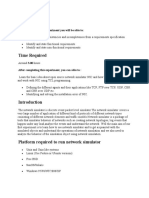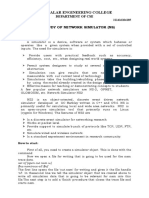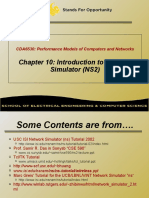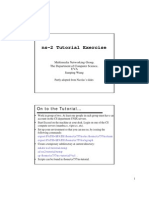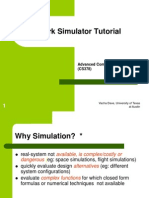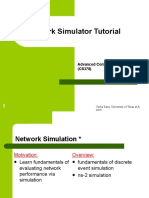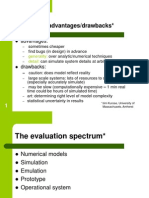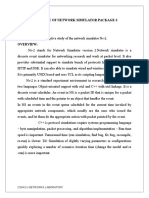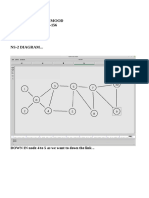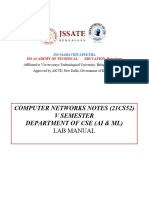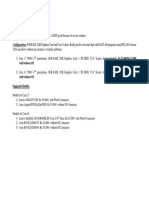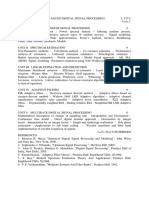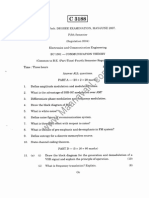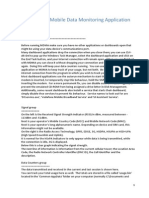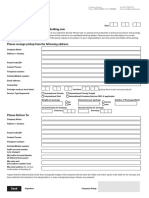Meivazhi Salai Andavargal
EC1354 Networks Lab
�The ns2 Tutorial
Prepared by
V. Salai Selvam
Assistant Professor & HOD
Department of Electronics & Communication Engineering
Sriram Engineering College, Perumalpattu 602 024
�Procedure (default) to open x-desktop for ns2 simulation
Select StartCygwinCygwin bash shell
Type at cygwin bash shell startx and press <enter> to open x-desktop
Type at x bash shell CD<sp>/usr/local/ns* and
Press <enter> to move to ns2 installation folder
�Procedure (default) to create and save your TCL simulation scripts
Open notepad
Write your TCL simulation scripts
Select Save as from File menu
Select All Files for Save as type from pop-up dialog
Select ANSI for Encoding
Type a name for the script file with .tcl extension
Select Save
�Command to run a simulation scripts
#Command to run a simulation script
ns <scriptfilename>.tcl
scriptfilename
Name of the simulation script file
�Steps to write a simulation script for ns2
@ Create a simulator object
@ [Set nam or other tracing]
@ Add nodes
@ [Set node parameters]
@ Add links
@ [Set link parameters]
@ Add agents
@ [Set agent parameters]
@ Create connections
@ [Set connection parameters]
@ Add traffics
@ [Set traffic parameters]
@ [Insert errors, network dynamics, routing]
@ Set up event scheduling
@ [Create control loops or procedures]
@ Run simulation
�Steps to write a simulation script for ns2 (contd)
Please remember, in a TCL script,
Anything that follows the symbol # in a line is a comment
Anything that is written in this color is a keyword
Anything that is written in this color is a user-defined pointer variable
Anything that is written in this color & inside < > is an option
�Create a simulator object
#Create a simulator object
set nsptr [new Simulator]
nsptr
Pointer to simulator object
�Related commands
$nsptr version
- Returns ns version
$nsptr now
- Returns present time
$nsptr halt
- Stop/pause simulation
$nsptr cancel
<event> - Cancels event event
$nsptr flush-trace Flushes all trace buffers in respective trace files
$nsptr after <dly> <event> Schedule <event> after a delay <dly>
$nsptr is-started - Returns true if simulator has started to run
nsptr
Pointer to simulator object
�Set nam or other tracing
#Set nam tracing
#Open nam trace file
set ntfptr [open ntfname.nam <permission>]
#Set trace type
$nsptr <namtracetype> $ntfptr
ntfptr
ntfname
nsptr
<permission>
<namtracetype>
Pointer to nam trace file ntfname created
Name of nam trace file
Pointer to simulator object created
r
Read Only
Read & Write
namtrace-all
Trace all traffic
namtrace-queue $src $dst
Trace traffic between src & dst
nodes; hence declare only after
declaring link between src & dst
10
�Set nam or other tracing (contd)
#Set other tracing
#Open other trace file
set tfptr [open tfname.tr <permission>]
#Set trace type
$nsptr <tracetype> $tfptr
tfptr
tfname
nsptr
<permission>
<tracetype>
Pointer to trace file tfname created
Name of trace file
Pointer to simulator object created
r
Read Only
Read & Write
trace-all
Trace all traffic
trace-queue $src $dst
Trace traffic between src & dst nodes;
hence declare only after declaring link
between src & dst
11
�Add nodes
#Add nodes
set ndh [$nsptr node]
ndh
Handle to node created
nsptr
Pointer to simulator object
12
�Set node parameters
#Set node parameters
$ndh <param> <val>
ndh
<param>
<val>
Handle to node
color
Color of node
shape
Shape of node
red
blue
green
And more for color
circle
box
hexagon
And more for shape
13
�Set node parameters (contd)
#Set node parameters
#Add label from specified time
$nsptr at <time> $ndh label \<text>\
nsptr
Pointer to simulator object
ndh
Handle to node
<time>
<num_double>
<text>
<anytext>
Schedule time in secs
Any text as label
14
�Add links
#Add links
$nsptr <ltype> $fnd $snd <bw> <dly> <qtype>
nsptr
fnd, snd
Pointer to simulator object
Handles to pair of nodes to be linked
<ltype>
simplex-link
duplex-link
Link type: simplex-link, unidirectional link;
duplex-link, bidirectional link
<bw>
<num_double>
Link bandwidth in bps: add Mb for Mbps
<dly>
<num_double>
Link delay in secs: add ms for milli secs
<qtype>
DropTail
FQ
SFQ
DRR
CBQ
RED
Queue type: Drop Tail, Fair Queue,
Stochastic Fair Queue, Deficit Round
Robin, CBQ, Random Early Discard
15
�Related commands
#Return instance variable head_ of link between fnd and snd
[$nsptr link $fnd $snd] head
#Return instance variable link_ of link between fnd and snd
[$nsptr link $fnd $snd] link
#Return instance variable queue_ of link between fnd and snd
[$nsptr link $fnd $snd] queue
nsptr
fnd, snd
Pointer to simulator object
Handles to link nodes
16
�Set link parameters
#Set link parameters
$nsptr <ltype>-op $fnd $snd <param> <val>
nsptr
fnd, snd
<ltype>
<param>
Pointer to simulator object
Handles to link nodes
simplex-link
duplex-link
color
Color of link
label
Label for link
queuePos
<val>
Link type: simplex-link, unidirectional link;
duplex-link, bidirectional link
red
blue
green
anytext
<num_double>
Queue position
And more for color
Any text as label
Number for queuePos
17
�Set link parameters (contd)
<param>
orient
<val>
right
Left
up
down
right-up
right-down
left-up
left-down
up-right
down-right
up-left
down-left
<deg_double>
Setting node position for animation
Orient second node to right of first node
Orient second node to left of first node
Orient second node straight up first node
Orient second node straight down first node
Orient second node to right of first node and up
Orient second node to right of first node and down
Orient second node to left of first node and up
Orient second node to left of first node and down
Orient second node up first node and right
Orient second node down first node and right
Orient second node up first node and left
Orient second node down first node and left
Orient second node at deg_double to left of first node
18
�Set link parameters (contd)
#Set queue size of link
$nsptr queue-limit $fnd $snd <limit>
nsptr
fnd, snd
<limit>
Pointer to simulator object
Handles to link nodes
<num_int>
Queue size in packets
19
�Set link parameters (contd)
#Set queue parameters of link
set qptr [[$nsptr link $fnd $snd] queue]
$qptr set <param> <val>
nsptr
Pointer to simulator object
fnd, snd
Handles to link nodes
qptr
Pointer to queue of link between fnd & snd
For all queue types
<param>
<val>
limit_
Queue size in packets
blocked_
Enabling/disabling queue block
unblock_on_resume_ Enabling/disabling automatic queue unblock
<num_int>
true, false
true, false
Number of packets
If true, queue is blocked; unable to sent packet to link
If true, queue is unblocked after last pkt is txed.
20
�Set link parameters (contd)
For Fair Queue (FQ)
<param>
secsPerByte_
<val>
<num_double>
Seconds per byte
For Stochastic Fair Queue (SFQ)
<param>
maxqueue_
buckets_
<val>
<num_int>
<num_int>
Maximum queue in packets
Number of buckets used for hashing of flow
For Deficit Round Robin (DRR)
<param>
buckets_
blimit_
quantum_
mask_
<val>
<num_int>
<num_int>
<num_int>
true, false
Number of buckets used for hashing of flow
Shared buffer size in bytes
Flow rate in bytes
If true, flow consists of packets with same node id
21
�Set link parameters (contd)
For Random Early Discard (RED)
bytes_
queue-in-bytes_
thresh_
maxthresh_
mean_pktsize_
<param>
q_weight_
wait_
linterm_
setbit_
drop-tail_
<val>
true, false
true, false
<num_double>
<num_double>
<num_int>
<num_double>
true, false
<num_double>
true, false
true, false
If true, byte-mode RED is enabled
If true, average queue size is measured in bytes
Minimum threshold for average queue size in packets
Maximum threshold for average queue size in packets
Rough estimate of average packet size in bytes
Queue weight, used for calculating average queue size
If true, interval between dropped pkts is maintained
Packet dropping probability varies bet 0 and (1/linterm)
If true,
If true, drop-tail is used when queue overflows
22
�Add agents
#Add agents
#Create desired agent
set agptr [new Agent/<agent>]
#Attach agent to desired node
$nsptr attach-agent $ndh $agptr
agptr
Pointer to agent created
nsptr
Pointer to simulator object
ndh
Handle to node to be attached with agent
<agent>
TCP
TCP/Reno
TCP/Newreno
TCP/Sack1
TCP/Fack
TCP senders
23
�Add agents (contd)
<agent>
TCP/FullTcp
TCP/Vegas
TCP/Vegas/RBP
TCP/Reno/RBP
TCP/Asym
TCP/Reno/Asym
TCP/Newreno/Asym
TCP senders
TCPSink
TCPSink/DelAck
TCPSink/Asym
TCPSink/Sack1
TCPSink/Sack1/DelAck
TCP receivers
UDP
UDP sender
Null
Null receiver that simply discards received packets
RTP
RTP sender/receiver
24
�Add agents (contd)
LossMonitor
<agent>
Packet sink which checks for losses
IVS/Source
IVS sender
IVS/Receiver
IVS receiver
CrtMcast/Encap
Centralized multicast encapsulator
CrtMcast/Decap
Centralized multicast de-encapsulator
Message
Protocol to carry text messages
Message/Prune
Processes multicast prune messages
SRM
SRM agent with non-adaptive timers
SRM/Adaptive
Tap
rtProto/DV
SRM agent with adaptive timers
Agent to interface simulator to live network
Distance vector routing protocol agent
25
�Add agents (contd)
26
�Add agents (contd)
27
�Add agents (contd)
28
�Set agent parameters
#Set agent parameters
#For configurable parameters
$agptr set <parameter> <value>
#For read only parameters
set pptr $agptr <parameter>
agptr
Pointer to agent created
pptr
Pointer to parameter read
<parameter> Configuration parameters common for all agents
fid_
prio_
agent_addr_
agent_port_
dst_addr_
dst_port_
An integer as flow ID
An integer as priority
An integer as address of this agent
Port no of this agent in integer
Destination address of this agent in integer
Destination port of this agent in integer
<parameter> Configuration parameters common for all source agents
packetSize_
Packet size in bytes
29
�Set agent parameters (contd)
<parameter> Configuration parameters for all source TCP agents
window_
maxcwnd_
windowInit_
windowOption_
maxburst_
MSW
Upper bound on advertised window for TCP connection in packets
Upper bound on congestion window in packets-Set to 0 to ignore
Initial congestion window size in packets
Algorithm to handle congestion window (0 to 8)
Maximum no of packets to send in response to single ACK
Maximum window size in packets for TCP-window_ <=MSW-1
<parameter> State variables (read only) for all source TCP agents
dupacks_
seqno_
t_seqno_
ack_
No of duplicate acks seen since new data was acknowledged
Highest sequence no for data from data source to TCP
Current transmit sequence no
Highest ack seen from receiver
<parameter> Configuration parameters for only TCP-DelAck agents
interval_
Delay in secs before generating ACK
<parameter> State variables (read only) for only Null agent
sport_
dport_
Port of source agent
Port of destination agent
30
�Set agent parameters (contd)
<parameter> State variables (read only) for only LossMonitor agent
nlost_
npkts_
bytes_
lastPktTime_
expected_
Number of packets lost
Number of packets received
Number of bytes received
Time at which last packet was received
Expected sequence number of the next packet
#Set flow color for agents
$nsptr color <fid_> <val>
nsptr
Pointer to simulator object
<fid_>
<num_int>
<val>
red
blue
green
Flow ID of agent considered
And more as flow color
31
�Create connection
#Create connection
$nsptr connect $srcag $dstag
nsptr
Pointer to simulator object
srcag
Pointer to desired source agent
dstag
Pointer to desired destination agent
32
�Add agents & Create connection-alternate
#Create desired agent, attach it to desired src node, connect it to desired dst
#node and returns ptr to src node created
set agptr [$nsptr create-connection <srcag> $srcndh <dstag> $dstndh
<pktclass>]
nsptr
Pointer to simulator object created
<srcag>
Source agent
<dstag>
Destination agent
srcndh
Pointer to source node
dstndh
Pointer to destination node
agptr
Pointer to source agent created
33
�Add agents & Create connection-alternate (contd)
#Create desired agent, attach it to desired src node, connect it to desired dst
#node and returns list of ptrs to src & dst nodes created
set agptrl [$nsptr create-connection-list <srcag> $srcndh <dstag> $dstndh
<pktclass>]
set sagptr [lindex $agptrl 0]
set dagptr [lindex $agptrl 1]
nsptr
Pointer to simulator object
<srcag>
Source agent
<dstag>
Destination agent
srcndh
Pointer to source node
dstndh
Pointer to destination node
agptrl
List of pointers to source and destination agents created
sagptr
Pointer to source agent created
dagptr
Pointer to destination agent created
34
�Add traffics
#Add traffic
#Create traffic
set trptr [new Application/<traffic>]
#Attach it to desired agent
$trptr attach-agent $agptr
trptr
Pointer to traffic created
agptr
Pointer to desired agent
FTP
Telnet
<traffic>
Traffic/CBR
Traffic/Exponential
Traffic/Pareto
FTP traffic for TCP agent
Telnet traffic for TCP agent
CBR traffic for UDP agent
Exponential traffic for UDP agent
Pareto traffic for UDP agent
35
�Set traffic parameters
#Set traffic parameters
$trptr set <param> <val>
trptr
Pointer to traffic created
For all traffic
<param>
packetSize_
rate_
<val>
<num_int>
<num_double>
Packet size in bytes
Traffic rate in bps
For CBR traffic
<param>
random_
maxpkts_
<val>
true, false
<num_double>
If true, random noise is introduced in traffic
Maximum number of packets
36
�Set traffic parameters (contd)
For Exponential traffic
<param>
burst_time_
idle_time_
<val>
<num_double>
<num_double>
Length of burst (on-time) in secs
Length of off-time in secs
For Pareto traffic
<param>
burst_time_
idle_time_
shape_
<val>
<num_double>
<num_double>
<num_double>
Length of burst (on-time) in secs
Length of off-time in secs
Pareto shape parameter
37
�Set up event scheduling
#Set up event scheduling
$nsptr at <time> <event>
nsptr
<time>
Pointer to simulator object
<num_double>
<event> <tcl_command>
Schedule time in secs
Any valid TCL command
38
�Set up event scheduling (contd)
#Selecting event scheduler before any event schedule
$nsptr use-scheduler <shdlr>
nsptr
Pointer to simulator object
List
Heap
<shdlr>
Calendar
ReatTime
Scheduler using a simple linked-list structure
Scheduler using a heap structure
Scheduler using a data structure analogous to year desk calendar
Scheduler using real time
39
�Set up event scheduling (contd)
#Some important event schedules
#Start traffic trptr at time
$nsptr at <time> $trptr start
#Stop traffic trptr at time
$nsptr at <time> $trptr stop
nsptr
Pointer to simulator object
trptr
Pointer to desired traffic
<time>
<num_double>
Schedule time in secs
40
�Set up event scheduling (contd)
#Annotating
$nsptr at <time> $nsptr trace-annotate \<text>\
#Set nam animation rate
$nsptr at <time> $nsptr set-animation-rate <rate>
#Finishing simulation
$nsptr at <time> finish
nsptr
Pointer to simulator object
finish
User-defined finish procedure; Refer to finish procedure
<time>
<num_double>
Schedule time in secs
<text>
<anytext>
Any text as annotation
<rate>
<num_double>
Animation rate in secs
41
�Run simulation
#Run simulation
$nsptr run
nsptr
Pointer to simulator object
42
�Creating procedures
#Creating procedures
proc pname {parg1 parg2 } {pbody}
pname
parg1, parg2
pbody
Procedure name by which it is called
Procedure arguments
Procedure body i.e., list of TCL commands to be executed
43
�Creating procedures (contd)
#finish procedure-a custom way to finish your simulation
proc finish {} {
#declaring nsptr, ntfptr as global variables
global nsptr ntfptr
#flush trace buffers to respective files
$nsptr flush-trace
#close all files
close $ntfptr
#open animation for this simulation
exec nam <ntfname>.nam &
#exit procedure normally
exit 0
}
nsptr
Pointer to simulator object
ntfptr
Pointer to nam trace file ntfname
ntfname
Name of nam trace file
44
�Insert error model
#Create error model
set errmod [new <errormodel>]
#Set errmodel parameters
$errmod set <param> <val>
#Set target for droped packets
$errmod drop-target [new Agent/Null]
errmod
Pointer to error model created
<errormodel>
ErrorModel
ErrorModel/Periodic
ErrorModel/Uniform
SelectErrorModel
ErrorModel/List
Simple error model
Modeling periodic packet drop
Uniform error model
For selective packet drop
Dropping specified list of packets
45
�Insert error model (contd)
For all error models
<param>
<val>
unit_ Error unit in pkts, bytes or time
pkts,
bytes,
time
For ErrorModel
<param>
enable_
rate_
delay_
bandwidth_
markecn_
delay_pkt_
<val>
true or false
<num_double>
<num_in_secs>
<num_in_bps>
true or false
true or false
True if this error module is turned on
Uniform error rate in pkt or byte
Time to delay packet
Bandwidth of the link
If true, ecn is marked instead of dropping on corruption
If true, packet is delayed instead of dropping
46
�Insert error model (contd)
For ErrorModel/Periodic
<param>
period_
offset_
burstlen_
default_drop_
<val>
<num_double>
<num_double>
<num_double>
true or false
Drop period in secs
Drop offset in secs
Drop length in secs
All pkts are dropped except last in period_ if true (1)
47
�Insert error model (contd)
For SelectErrorModel
<param>
enable_
rate_
delay_
bandwidth_
markecn_
delay_pkt_
pkt_type_
drop_cycle_
drop_offset_
<val>
true, false
<num_double>
<num_double>
<num_double>
true, false
true, false
0, 1 or 2
<no_of_pkts>
<no_of_pkts>
True if this error module is turned on
Uniform error rate in pkt or byte
Time to delay packet
Bandwidth of the link
Mark ecn instead of dropping on corruption?
Delay packet instead of dropping?
0,1 or 2 (TCP, UDP or CBR packet)
Drop pkts after every drop_cycle_
No of pkts to be dropped
48
�Insert error model (contd)
For ErrorModel/List
<param>
cnt_
droplist_
dropcnt_
cur_
<val>
<num_int>
<num_int_list>
<num_int>
<num_int>
Count of pkts/bytes we've seen
Array of pkt/byte numbers to affect
Number of entries in droplist_ total
Current index into droplist_
49
�Insert error model (contd)
#Optional: Set random variable before setting drop-target
$errmod ranvar [new RandomVariable/<ranvar>]
errmod
Pointer to error model created
ranvar
Pointer to random variable created
<ranvar>
Uniform, Exponential, Pareto,
ParetoII, Constant,
HyperExponential, Empirical,
Normal, LogNormal, Weibull
Random variable type for random
generator
50
�Insert error model (contd)
#Place error model on simple link just before the queue
$nsptr lossmodel $errmod $srcndh $dstndh
or
#Place error model on simple link just after the queue
$nsptr link-lossmodel $errmod $srcndh $dstndh
errmod
Pointer to error model created
nsptr
Pointer to simulator object created
srcndh, dstndh
Node handles to desired node pair
51
�Insert error model (contd)
#Generate random variable using desired distribution with desired parameters
set rng [new RNG]
$rng seed <seedvalue>
set ranvar [new RandomVariable/<ranvar>]
$ranvar set <param> <val>
$ranvar use-rng $rng
rng
ranvar
Pointer to random generator created
Pointer to random variable created
<seedvalue>
<num_double>
Seed value for random generator
<ranvar>
Uniform, Exponential, Pareto,
ParetoII, Constant,
HyperExponential, Empirical,
Normal, LogNormal, Weibull
Random variable type for random
generator
52
�Insert error model (contd)
<param> & <val> Configurable parameters & their values for Uniform
min_
max_
<num_double>
<num_double>
Start value for distribution
End value for distribution
<param> & <val> Configurable parameters & their values for Exponential
avg_
<num_double>
Average value for distribution
<param> & <val> Configurable parameters & their values for Pareto & ParetoII
avg_
shape_
<num_double>
<num_double>
Average value for distribution
Shape value for distribution
<param> & <val> Configurable parameters & their values for Constant
val_
<num_double>
Value for distribution
<param> & <val> Configurable parameters & their values for HyperExponential
avg_
cov_
<num_double>
<num_double>
Average value for distribution
Covariance value for distribution
53
�Insert error model (contd)
<param> & <val> Configurable parameters & their values for Normal &
LogNormal
avg_
<num_double>
Average value for distribution
std_
<num_double>
Standard deviation value for distribution
<param> & <val> Configurable parameters & their values for Empirical
minCDF_
maxCDF_
interpolation_
maxEntry_
<num_double>
<num_double>
0, 1 or 2
<num_int>
Min CDF value
Max CDF value
Interpolation method;
Size of CDF table
<param> & <val> Configurable parameters & their values for Weibull
shape_
scale_
<num_double>
<num_double>
Shape for distribution
Scale for distribution
54
�Insert network dynamics
#Set network dynamics
$nsptr rtmodel <rtmodel> <ts> $src $dst
or
$nsptr rtmodel-at <time> <lnkst> $src $dst
nsptr
src, dst
Pointer to simulator object
Handles to src & dst nodes of link
<rtmodel>
Trace
Exponential
Deterministic
Manual
<ts>
$tracefile
{<stt> <upp> <dnp> <fin>}
{<stt> <upp> <dnp> <fin>}
<time> <lnkst>
Up/down the link as per a trace file tracefile
Up/down the link exponentially as per <ts>
Up/down the link deterministically as per <ts>
Up/down the link manually <ts>
Trace file already opened
Time schedule, all in secs
Time schedule, all in secs
Schedule time in secs and link status
55
�Insert network dynamics (contd)
<stt>, <upp>,
<dnp>, <fin>
<num_double>
stt-start time; upp-link-up interval; dnp-linkdown interval; fin-stop time
<time>
<num_double>
Schedule time in secs
<lnkst>
up or down
Up or down the link
56
�Insert network dynamics (contd)
#Simply upping and downing a link e.g., link srcdst
#Getting link_ for link of interest
set lin [$nsptr link $src $dst]
#Setting link srcdst as dynamic
$lin dynamic
#Scheduling link dynamics for link srcdst
$nsptr at <time> $lin <lnkst>
lin
nsptr
src, dst
Pointer to link srcdst
Pointer to simulator object
Handles to nodes on link srcdst
<lnkst>
up or down
<time>
<num_double>
Up or down the link
Schedule time in secs
57
�Insert routing
#Select routing protocol
$nsptr rtproto <rtprotcol> <$nodelist>
nsptr
Pointer to simulator object
<rtprotcol>
<$nodelist>
Static
Session
DV
LS
Manual
hierarchical
Static or Shortest Path routing algorithm
Session routing algorithm
Distance Vector routing algorithm
Link State routing algorithm
Manual
Hierarchical routing algorithm
$n0 $n1 ...
Selected routing algorithm applied to selected list
of nodes; if not specified, selected algorithm
applies to all nodes
58
�Insert routing (contd)
#Steps for manual routing
#Enable manual routing with rtproto
$nsptr rtproto Manual <$nodelist>
#Set default routes for all pairs of src and dst that are linked in given
#topology, if srcdst is simplex-link, as
[$src get-module Manual] add-route-to-adj-node -default $dst
#or if srcdst is duplex-link, add default route for reverse link also as
[$dst get-module Manual] add-route-to-adj-node -default $src
nsptr
src, dst
Pointer to simulator object
Pair of nodes that are linked in given topology
<$nodelist>
$n0 $n1 ...
Selected routing algorithm applied to selected list
of nodes; if not specified, selected algorithm
applies to all nodes
59
�Insert routing (contd)
#Set actual route for a pair of src and dst if desired path between them is
#e.g., srcimn1 and imn1dst, if srcimn1 & imn1dst are simplex-link, as
[$src get-module Manual] add-route-to-adj-node $imn1
[$imn1 get-module Manual] add-route-to-adj-node $dst
#or if srcimn1 & imn1dst are duplex-link, set reverse path
#dstimn1 & imn1src also as
[$dst get-module Manual] add-route-to-adj-node $imn1
[$imn1 get-module Manual] add-route-to-adj-node $src
src, dst, imn1
Nodes that are linked in given topology
60
�Creating LAN
#Steps to create a LAN
#Step 1: Create new simulator object
#Step 2: Set NAM tracing
#Step 3: Add nodes
#Step 4: Add links if required
#Step 5: Create LAN including all or some nodes created
#Step 6: Add agents & Add traffics
#Step 7: Set event scheduling
#Step 8: Run simulation
61
�Creating LAN (contd)
#Step 5: Creating LAN and adding all or some nodes created
$nsptr make-lan <nodelist> <bw> <dly> <LL> <ifq> <MAC> <chan> <phy>
or
set lanptr [$nsptr newLan <nodelist> <bw> <dly> <LL> <ifq> <MAC> <chan>
<phy>]
nsptr
Pointer to simulator object
<nodelist>
$ndh1 $ndh2
List of nodes to connected in the LAN
<bw>
<num_double>
Bandwidth in bps
<dly>
<num_double>
Delay in secs
<LL>
LL
<ifq>
Queue/DropTail
<MAC>
Mac/Csma/Cd
Mac/Csma/Ca
(Data) Link Layer
Interface queue type
CSMA/CD LAN protocol
CSMA/CA LAN protocol
62
�Creating LAN (contd)
<MAC>
Mac/802_3
Mac/802_11
10Mbps LAN connectivity
Wireless LAN protocol
<chan>
Channel
WirelessChannel
Channel type for wired LAN
Channel type for wireless LAN
<phy>
Phy/WiredPhy
Phy/WirelessPhy
Network interface for wired LAN
Network interface for wireless LAN
63
�Creating mobile network
#Steps to create a mobile network
#Step 1: Set mobile net options
#Step 2: Set parameters for selected mobile net options
#Step 3: Create new simulator object
#Step 4: Set nam and other tracings
#Step 5: Create topography and GOD for mobile net
#Step 6: Set mobile node configurations
#Step 7: Create nodes as many as nmn
#Step 8: Set initial positions and sizes for mobile nodes
#Step 9: Set scheduled or random movements for mobile nodes
#Step 10: Add agents, Connect them and Add traffics
#Step 11: Set event scheduling for traffics
#Step 12: Reset nodes when simulation ends
#Step 13: Stop nam when simulation ends
#Step 14: Call finish to finish
64
�Creating mobile network (contd)
#Step 1: Define mobile net options
set opt(chan) <chan>
set opt(prop) <prop>
set opt(phy) <phy>
set opt(mac) <mac>
set opt(ifq) <ifq>
set opt(ll) <ll>
set opt(ant) <ant>
set opt(ifqlen) <ifqlen>
set opt(nmn) <nmn>
set opt(rtp) <rtp>
set opt(x) <x>
set opt(y) <y>
set opt(seed) <seed>
set opt(stp) <stp>
65
�Creating mobile network (contd)
opt()
<chan>
<prop>
Array to options
Channel/WirelessChannel
Channel type
Propagation/TwoRayGround Radio-propagation model
<phy>
Phy/WirelessPhy
Network interface type
<mac>
Mac/802_11
<ifq>
Queue/DropTail/PriQueue
CMUPriQueue
<ll>
LL
Link layer type
<ant>
Antenna/OmniAntenna
Antenna type
<ifqlen>
<num_int>
Maximum queue length in packets
<nmn>
<num_int>
Number of mobile nodes
Mac type
Interface queue type for dsdv
Interface queue for dsr
66
�Creating mobile network (contd)
<rtp>
DSDV
DSR
TORA
AODV
<x>
<num_double>
X dimension of topography
<y>
<num_double>
Y dimension of topography
<seed>
<num_double>
Seed for random num generation
<stp>
<num_double>
Simulation end time in secs
Destination Sequence Distance Vector
Dynamic Source Routing
Temporally ordered Routing Algorithm
Adhoc On-demand Distance Vector
67
�Creating mobile network (contd)
#Step 2: Set Phy/WirelessPhy parameters
Phy/WirelessPhy set <param> <val>
<param>
CPThresh_
CSThresh_
RXThresh_
Pt_
freq_
L_
<val>
<num_double>
<num_double>
<num_double>
<num_double>
<num_double>
<num_double>
Capture threshold in dB
Carrier sense threshold in watts
Receive power threshold in watts
Transmitted signal power in watts
Frequency in Hz
System loss factor
68
�Creating mobile network (contd)
#Step 2: Set LL parameters
LL set <param> <val>
<param>
mindelay_
delay_
bandwith_
<val>
<num_double>
<num_double>
<num_double>
Minimum delay in secs
Delay in secs
Bandwith in bps
69
�Creating mobile network (contd)
#Step 2: Set Antenna/OmniAntenna parameters
Antenna/OmniAntenna set <param> <val>
<param>
X_
Y_
Z_
Gt_
Gr_
<val>
<num_double>
<num_double>
<num_double>
<num_double>
<num_double>
X position of antenna
Y position of antenna
Z position of antenna
Transmitting gain of antenna in dB
Receiving gain of antenna in dB
70
�Creating mobile network (contd)
#Step 4: Set nam & other tracings
set ntfptr [open ntfname.tr <permission>]
$nsptr namtrace-all-wireless $ntfptr $opt(x) $opt(y)
ntfptr
ntfname
nsptr
opt(val)
<permission>
Pointer to nam trace file ntfname
Name of nam trace file
Pointer to simulator object
Respective opt array element
r
w
Read only
Read/write or create
71
�Creating mobile network (contd)
#Step 5: Create topography & GOD for mobile net
set topo [new Topography]
$topo load-flatgrid $opt(x) $opt(y)
create-god $opt(nmn)
topo
opt(val)
Pointer to new topography created
Respective opt array element
72
�Creating mobile network (contd)
#Step 6: Set mobile node configurations
$nsptr node-config <param> $<opt>
<param>
-addressingType
-adhocRouting
-llType
-macType
-propType
-ifqType
-ifqLen
-phyType
-antType
-channelType
-topoInstance
-wiredRouting
-mobileIP
-energyModel
<opt>
opt(val)
usually flat or hierarchical used for wireless topologies
Adhoc rotuing protocol like DSDV, DSR, TORA, AODV etc
LinkLayer
MAC type like Mac/802_11
Propagation model like Propagation/TwoRayGround
Interface queue type like Queue/DropTail/PriQueue
Interface queue length like 50
Network inteface type like Phy/WirelessPhy
Antenna type like Antenna/OmniAntenna
Channel type like Channel/WirelessChannel
Topography instance
Turning wired routing ON or OFF
Setting the flag for mobileIP ON or OFF
EnergyModel type
Respective opt array element already defined
73
�Creating mobile network (contd)
<param>
initialEnergy
rxPower
txPower
agentTrace
routerTrace
macTrace
movementTrace
<opt>
opt(val)
Specified in Joules
Specified in W
Specified in W
Tracing at agent level turned ON or OFF
Tracing at router level turned ON or OFF
Tracing at mac level turned ON or OFF
Mobilenode movement logging turned ON or OFF
Respective opt array element already defined
74
�Creating mobile network (contd)
#Step 8: Set initial positions and sizes for mobile nodes
$ndh set <pos> <val>
$nsptr initial_node_pos $ndh <size>
ndh
Handle to node
nsptr
Pointer to simulator object
<pos>
X_
Y_
Z_
<val>
<num_double>
X coordinate
Y coordinate
Z coordinate
75
�Creating mobile network (contd)
#Step 9: Set scheduled or random movements for mobile nodes
#For scheduled movements
#Set random-motion false for scheduled motions to take place
$ndh random-motion 0
$nsptr at <time> $ndh setdest <x> <y> <speed>
<time>
<num_double>
Schedule time in secs
<x>, <y>
<num_double>
X and Y coordinates for new position
<speed>
<num_double>
Speed of movement in m/s
#For random movements
$ndh random-motion <arg>
$nsptr at <time> $ndh start
<time>
<num_double>
<arg>
true or false
0 or 1
Schedule time in secs
Random motion of node ndh is enabled if true or 1
76
�Creating mobile network (contd)
#Step 12: Reset nodes when simulation ends
$nsptr at $opt(stp) $ndh reset
nsptr
Pointer to simulator object
ndh
Handle to node
opt(val)
Respective opt array element
77
�Creating mobile network (contd)
#Step 13: Stop nam when simulation ends
$nsptr at $opt(stp) $ndh nam-end-wireless $opt(stp)
nsptr
Pointer to simulator object
ndh
Handle to node
opt(val)
Respective opt array element
78
�Creating mobile network (contd)
# Step 14: Call finish to finish
$nsptr at <time> finish
proc finish {} {
#declaring nsptr, ntfptr as global variables
global nsptr ntfptr
#flush trace buffers to respective files
$nsptr flush-trace
#close all files
close $ntfptr
#stop simulation-not necessary if step 13 is used
$nsptr halt
#open animation for this simulation
exec nam <ntfname>.nam &
exit 0
}
79


